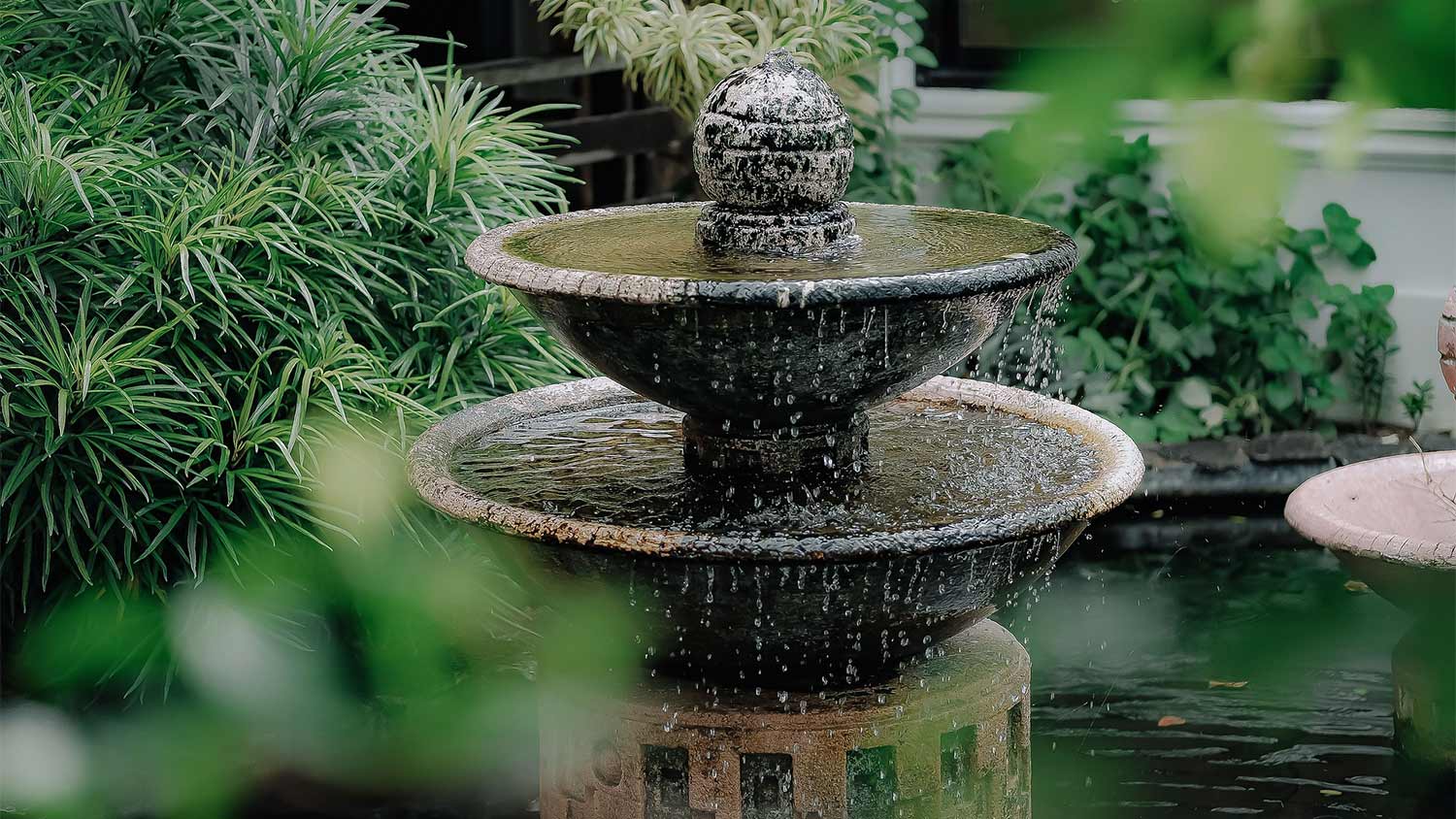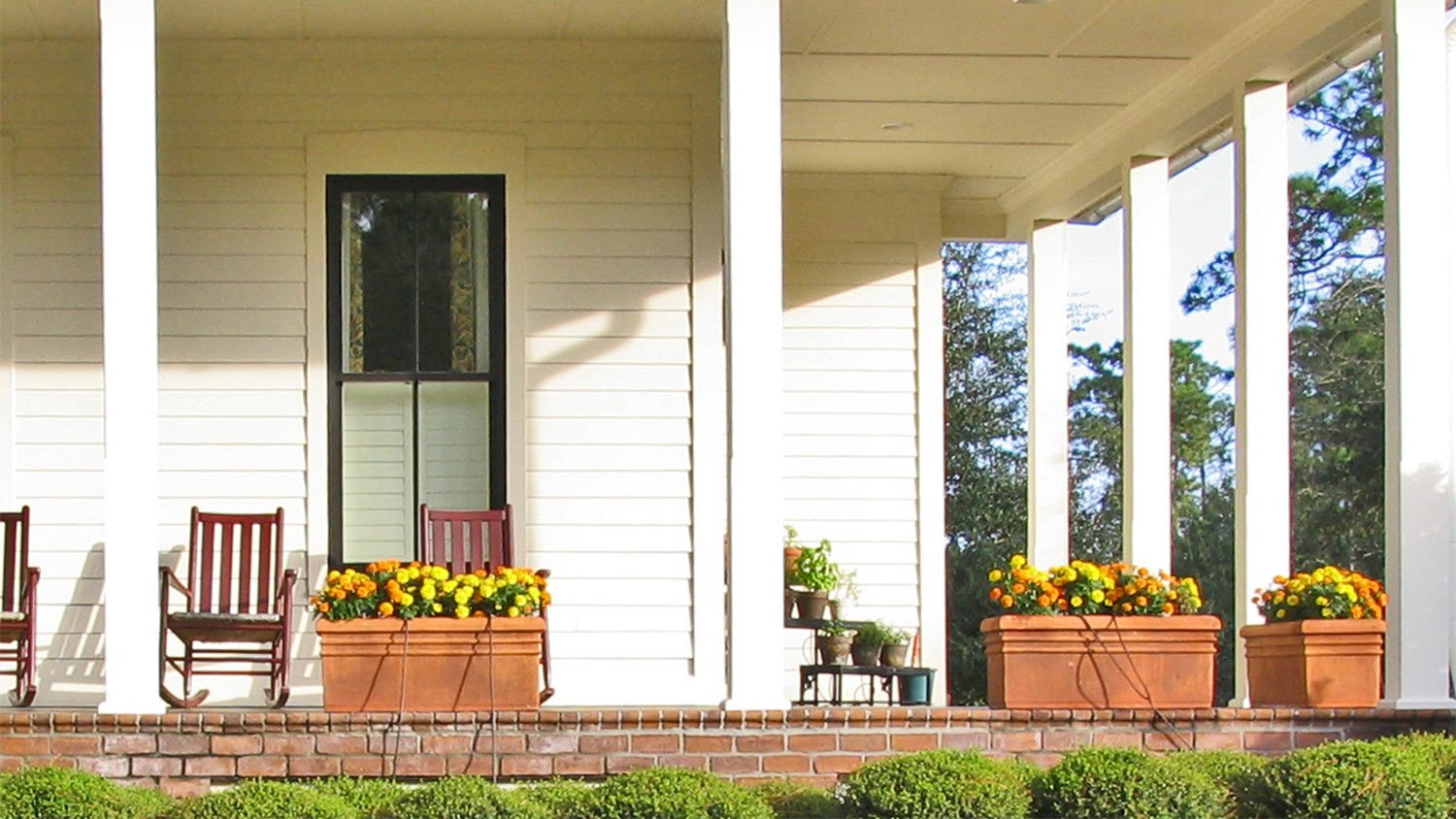Get Inspired by These 14 Creative Landscape and Lawn Designs for Historical Homes
Just because it’s historical doesn’t mean your home can’t also be trendy


Planning a historic home renovation can feel intimidating, especially when you have a lot of land to work with and a unique architectural design. Examining your type of home architecture is an excellent place to start, as it may provide clues about how the grounds originally looked.
Whether you want to preserve an old house or mimic a garden style from generations ago, these 14 landscape designs will be sure to help you get inspired to create a historically fashionable look.
1. Georgian-Style Landscaping

Georgian-style architecture originated in the 1700s to the 1830s and used simple landscaping, sectioned garden beds, and many linear, symmetrical constructions to achieve an impressive aesthetic. Here, you can see simple yet elegant hints of sophistication through the use of metal fencing, manicured shrubs, and clear-cut grass. This design is ideal for anyone looking to achieve a stunning landscape without the high maintenance of a more robust garden.
2. Mix It Up

The style of natural English gardens and Greek building elements began to emerge after the Georgian landscaping. The emerging design, called the Greek Revival, is often regarded as the country’s first national architecture style, and it inspired many Americans to create beautiful landscapes.
To achieve this look, you can include clumps of trees, shrubs, landscaping perennials, and brick paths. The goal is to mix it up and stray away from some of that symmetry in earlier landscaping designs.
3. Gravel Walkways

A simple way to add dimension to your yard is by using gravel to line pathways and driveways. Gravel adds a natural layer to the landscape while enhancing the effects of the most curb-appealing features of your historic home. If you have a unique doorway, porch, or awning, use the gravel to lead up to these focal points and make them stand out even farther.
4. Add a Pool

Pools aren’t technically associated with historic homes, as the first pool wasn’t built until 1887, and pools didn’t become commercialized until the 1940s. Either way, a pool is an undeniably stunning feature that you can add to your historic home to merge the old with the new and modern. For Georgian homes, a linear pool will accentuate those symmetrical features further; for more classical Greek and Victorian designs, asymmetrical pool shapes—like oval, circle, and L-shaped pools—can bring out those lush garden beds.
5. Impermeable Pavers

Impermeable pavers come in many shapes and patterns, and the best part is they’re better at reducing storm runoff and preventing flooding. In older homes in historic districts, drainage systems can be more outdated than in newer communities that have more land for water to spread out. Concrete pavers add dimension to your yard and can accentuate that porch or entryway of your historic home.
You can also use them to create walkways in your gardens. For that pristine grass, some pavers have spaces in the middle for pops of green to poke out, adding even more style to your yard.
6. Water Features

Natural-looking water features like fountains, pools, and grotto fountains (disappearing fountains where the water cascades into caves) are peaceful landscape designs that can make a plain yard feel more elegant and calming. You can use a water feature as a standalone feature or pair it with a pond, concrete pavers, or shrubs to create a stunning look in your yard.
7. Make Use of Statues

Speaking of stunning looks, don’t underestimate the effect of a good statue. Many historic homes tote impressive pillars or entryways that could benefit from large feature pieces like these lions. But statues don’t have to end there. From bird bath statues to angels, statues in your backyard can also have a tremendous impact on the appearance of your yard.
8. Simple Lines

Styles such as Arts & Crafts and Craftsman emphasized traditional workmanship, resulting in the straightforward lines typical of homes from this period. Such ideas found their way into backyard landscaping ideas, where angular stairways, windows, and walkways came to dominate.
9. Patios and Terraces

If your historic property has an architectural style such as Arts and Crafts or Craftsman, chances are your home possesses features that emphasize traditional workmanship. In other words, you have straight lines that go well with simple terraces and patios. Historical homes of these styles often incorporated neutral exterior color palettes like stone and brick to blend in with natural elements.
10. Add Hardscaping Landscaping

A little bit of hardscaping can go a long way for your garden. Stone garden beds like this one from Julia Chasman Design both contain shrubs and create a wall that adds structure to what would otherwise be an open lawn. You can design historic garden beds with hardscaping materials in all shapes and sizes, so, depending on your home’s building material, you might opt for a red brick or a natural beige stone.
11. Planter Box Annuals

Potted annuals help to brighten historic homes with large patios and porches. Choosing potted annuals is a simple yet effective way to add historic charm to your home’s landscape without hiring a local landscaper to excavate your yard or make major changes that would require a lengthy project.
12. Terracotta Pots

Another simple take at upgrading your historical home is to incorporate neutral colors to blend in with the natural elements of your home. Potted annuals help to brighten patios and porches, so keep that in mind when generating front-yard landscaping ideas for a home from this era. Also consider brick walls, as pictured above, or the more natural evergreen hedges, which were valued for privacy.
13. Gazebos, Pergolas, and Arbors

More decorative than preceding styles, Queen Anne and Victorian architecture inspired lavish landscape designs. Front lawn ideas commonly included shade trees and large flower beds with bright annuals. Trellises on the porch for vines such as Boston ivy and Virginia creeper were popular curb appeal ideas.
As for the backyard, gardens often featured a few ornamental plants to heighten the visual appeal. Croquet grounds, gazebos, and arbors provided the perfect setting for summer lawn parties—an effect you can recreate with spaces that encourage socializing.
14. Concrete Pathways

Other historic homes have such linear structures that concrete and shrubs offer the perfect landscaping for making those features even more pronounced and attractive. A big landscaping project like this one has a high reward of sheer sophistication.





- Landscapers
- Tree Surgeons
- Gardening Services
- Landscape Architects
- Sod Installation
- Tennis Court Contractors
- Landscape Design
- Retaining Wall Companies
- Grading Companies
- Landscape Rock & Sand Delivery
- Mulch Delivery Services
- Pond Companies
- Artificial Grass Companies
- Shrub Removal & Trimming
- Backyard Design Companies
- Commercial Landscaping
- Koi Pond Services
- Backyard Landscapers
- Trampoline Assembly
- Hedge Trimming
- Pond Services
- Garden Design
- Outdoor Plant Watering
- Putting Greens
- French Drains
- Turf Installation
- Sod Removal Services
- Lawn Repair Services
- Brush Chipping Services
- Hardscape Contractor
- Landscape Rock Removal
- 47 Landscaping Ideas to Consider for Your Home
- 41 Backyard Landscaping Ideas for Next-Level Outdoor Living
- 21 Front Yard Landscaping Ideas to Boost Your Curb Appeal
- Historic Home Renovation Guide: Everything You Need to Know
- 18 Low-Maintenance Landscaping Ideas
- 13 Genius Low-Maintenance Front Yard Landscaping Ideas
- How to Landscape Around Your House: 8 Helpful Tips
- 9 Garden Styles to Inspire Your Outdoor Sanctuary
- Does Landscaping Increase Your Home Value?
- The Best Exterior Colors for Historic Homes










